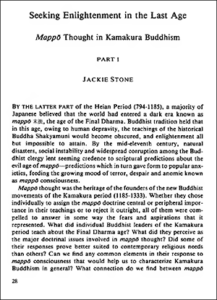Day 10 concludes Chapter 6, Assurance of Future Buddhahood, and opens Chapter 7, The Parable of a Magic City.
Having last month considered the prediction for Subhūti, we consider the prediction for Great Kātyāyana.
Thereupon the World-Honored One said to the bhikṣus:
“Now I will tell you. This Great Kātyāyana will make many offerings to eight hundred thousand millions of Buddhas, attend on them, respect them, and honor them in his future life. After the extinction of each of those Buddhas, he will erect a stūpa-mausoleum a thousand yojanas high, and five hundred yojanas wide and deep. He will make it of the seven treasures: gold, silver, lapis lazuli, shell, agate, pearl and ruby. He will offer flowers, necklaces, incense to apply to the skin, incense powder, incense to burn, canopies, banners and streamers to this stūpa-mausoleum. After that he will make the same offerings to two billions of Buddhas. Having made offerings to those Buddhas, he will complete the Way of Bodhisattvas, and become a Buddha called Jambunada-Gold-Light, the Tathāgata, the Deserver of Offerings, the Perfectly Enlightened One, the Man of Wisdom and Practice, the Well-Gone, the Knower of the World, the Unsurpassed Man, the Controller of Men, the Teacher of Gods and Men, the Buddha, the World-Honored One. The ground [of his world] will be even, made of crystal, and adorned with jeweled trees. The roads will be marked off by ropes of gold, and wonderful flowers will cover the ground to purify it. Anyone will rejoice at seeing it. The four evil regions: hell, the region of hungry spirits, that of animals, and that of asuras, will not exist in that world. Many gods and men will live there. Śrāvakas and Bodhisattvas, many billions in number, also will live there to adorn that world. The duration of the life of that Buddha will be twelve small kalpas. His right teachings will be preserved for twenty small kalpas, and the counterfeit of his right teachings also will be preserved for twenty small kalpas.”
Thereupon the World-Honored One, wishing to repeat what he had said, sang in gāthās:
Bhikṣus!
Listen with one mind!
What I say
Is true, not false.This Kātyāyana
Will make
Wonderful offerings
To the Buddhas.After the extinction of each of the Buddhas,
He will erect a stūpa of the seven treasures,
And offer flowers and incense to the śarīras
[Of the Buddha enshrined in the stūpa].On the final stage of his physical existence,
He will obtain the wisdom of the Buddha
And attain perfect enlightenment.
His world will be pure.
He will save many billions of living beings.
All living beings
In the worlds of the ten quarters
Will make offerings to him.No light will surpass
The light of that Buddha.
The name of that Buddha will be
Jambu [nada]-Gold-Light.Innumerable Bodhisattvas and Śrāvakas
Will live in his world, and adorn that world.
They will have already eliminated
The bonds of existence.

